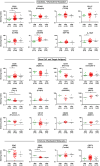Phenotypic characterization of disease-initiating stem cells in JAK2- or CALR-mutated myeloproliferative neoplasms
- PMID: 36814396
- PMCID: PMC10952374
- DOI: 10.1002/ajh.26889
Phenotypic characterization of disease-initiating stem cells in JAK2- or CALR-mutated myeloproliferative neoplasms
Abstract
Myeloproliferative neoplasms (MPN) are characterized by uncontrolled expansion of myeloid cells, disease-related mutations in certain driver-genes including JAK2, CALR, and MPL, and a substantial risk to progress to secondary acute myeloid leukemia (sAML). Although behaving as stem cell neoplasms, little is known about disease-initiating stem cells in MPN. We established the phenotype of putative CD34+ /CD38- stem cells and CD34+ /CD38+ progenitor cells in MPN. A total of 111 patients with MPN suffering from polycythemia vera, essential thrombocythemia, or primary myelofibrosis (PMF) were examined. In almost all patients tested, CD34+ /CD38- stem cells expressed CD33, CD44, CD47, CD52, CD97, CD99, CD105, CD117, CD123, CD133, CD184, CD243, and CD274 (PD-L1). In patients with PMF, MPN stem cells often expressed CD25 and sometimes also CD26 in an aberrant manner. MPN stem cells did not exhibit substantial amounts of CD90, CD273 (PD-L2), CD279 (PD-1), CD366 (TIM-3), CD371 (CLL-1), or IL-1RAP. The phenotype of CD34+ /CD38- stem cells did not change profoundly during progression to sAML. The disease-initiating capacity of putative MPN stem cells was confirmed in NSGS mice. Whereas CD34+ /CD38- MPN cells engrafted in NSGS mice, no substantial engraftment was produced by CD34+ /CD38+ or CD34- cells. The JAK2-targeting drug fedratinib and the BRD4 degrader dBET6 induced apoptosis and suppressed proliferation in MPN stem cells. Together, MPN stem cells display a unique phenotype, including cytokine receptors, immune checkpoint molecules, and other clinically relevant target antigens. Phenotypic characterization of neoplastic stem cells in MPN and sAML should facilitate their enrichment and the development of stem cell-eradicating (curative) therapies.
© 2023 The Authors. American Journal of Hematology published by Wiley Periodicals LLC.
Conflict of interest statement
P.V. received research grants from Celgene/BMS and AOP Orphan, and received consultancy honoraria from Novartis, Celgene/BMS, Pfizer, Incyte, and AOP Orphan. S.M.S. received travel support from Kite/Gilead and honoraria from Novartis, Jazz Pharmaceutics, Amgen, Celgene/BMS, Gilead, Servier, and AbbVie. M.F. received honoraria from Novartis, Amgen, Takeda, Celgene/BMS, Sanofi‐Aventis, Diagnosia, Sobi, MedAHEAD. T.S. received honoraria from Novartis, AbbVie, and Celgene/BMS. M.K. received honoraria from Amgen, Celgene/BMS, Janssen, Takeda, Pfizer, Sanofi, GSK, AbbVie, Novartis, and AOP Orphan. W.R.S. received honoraria from Novartis, Pfizer, AbbVie, Daiichi Sankyo, Stem line, Thermo Fisher, Deciphera, Celgene/BMS, and Jazz. E.K. received consultancy honoraria from AbbVie, Astellas, Jazz, Servier, and Celgene/BMS. M.P. received honoraria from Celgene/BMS, AbbVie, Jazz, Novartis, Sobi, and Takeda. The other authors declare no conflict of interest.
Figures




References
-
- Campbell PJ, Green AR. The myeloproliferative disorders. N Engl J Med. 2006;355(23):2452‐2466. - PubMed
-
- Kralovics R. Genetic complexity of myeloproliferative neoplasms. Leukemia. 2008;22(10):1841‐1848. - PubMed
-
- Skoda RC, Duek A, Grisouard J. Pathogenesis of myeloproliferative neoplasms. Exp Hematol. 2015;43(8):599‐608. - PubMed
-
- Spivak JL. Myeloproliferative neoplasms. N Engl J Med. 2017;376(22):2168‐2181. - PubMed
Publication types
MeSH terms
Substances
LinkOut - more resources
Full Text Sources
Medical
Research Materials
Miscellaneous
